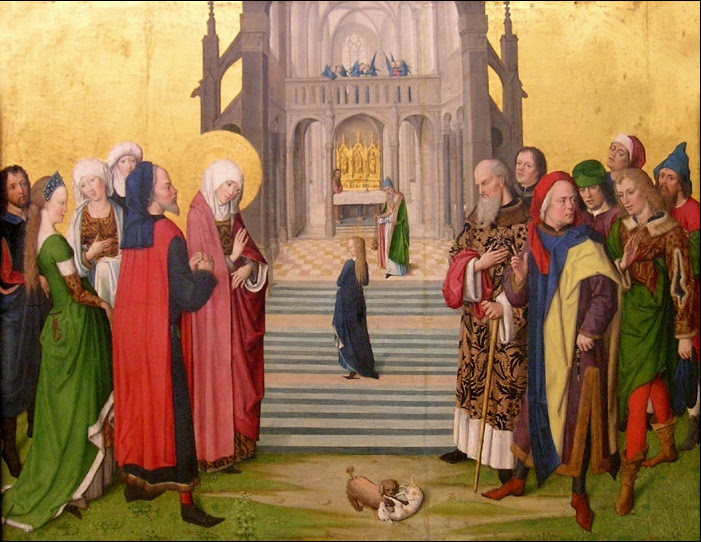 |
| c1460-5 |
The basis for the feast of the Presentation lies in the infancy narrative contained in the
Protoevangelium of James, which was possibly written around 145 AD, though the feast itself dates from 543.
Some modern historians claim the Protoevangelium is a fraud, as it does not reflect an awareness of the Judaism of the time, claiming, for example, that the idea of temple virgins is a conflation of Roman practice.
In reality, however, there are explicit Old Testament references to
vows of celibacy. In addition, there were several contemporary Jewish groups with close connections to Jesus and his family, such as the
Essenes, that did practice celibacy. And we also have from Scripture the story of the Prophetess Anna (Lk 2:25-35), who lived constantly in the Temple.
Accordingly, though not inspired Scripture, the early date of the Protoevangelium of James suggests that it should be taken seriously as relating a genuine early historical tradition regarding to Our Lady.
According to the text, Mary's parents, Joachim and Anne, who had been childless, received a heavenly message that they would bear a child. In thanksgiving for the gift of their daughter, they brought her, when still a child, to the Temple in Jerusalem to consecrate her to God, and she was educated for her future role there.
St Columbanus

St Columbanus (540-615) was an Irish monk missionary responsible for founding many monasteries on the continent. His brand of monasticism was much stricter and more penitential in orientation than St Benedict's, and the two rules were often used in combination.
St Columbanus suffered early temptations, and sought out advice from a holy woman who advised him to retire from the world; his decision was, however, strongly opposed by his parents.
His first master was Sinell, Abbot of Cluaninis in Lough Erne. Under his tuition he composed a commentary on the Psalms. He then went to the monastery of Bangor under St Comgall. There he embraced the monastic state, and for many years led a life conspicuous for fervour, regularity, and learning.
At about the age of forty he seemed to hear incessantly the voice of God bidding him preach the Gospel in foreign lands. At first his abbot declined to let him go, but at length he gave consent.
Columbanus set sail with twelve companions. They eventually arrived in France around 585.
He and his followers soon made their way to the court of Gontram, King of Burgundy, who invited him to establish a monastery at Annegray in the solitudes of the Vosges Mountains. After a few years the ever-increasing number of his disciples oblige him to build another monastery, which he established at Luxeuil, in 590. A third followed at Fontaines.
His efforts ran into opposition from the local bishops, however, in part because he insisted on the Irish rather than Roman date for the celebration of Easter, but after assorted appeals to Rome, appears to have given way on this.
He also ran into trouble with the local king: the young King Thierry, to whose kingdom Luxeuil belonged, was living a life of debauchery, and was encouraged in this by his grandmother (his regent) who wanted no rivals for power. Thierry, however, continued to visit the saint, who admonished and rebuked him, but in vain.
St Columbanus was taken prisoner but escaped, whereupon the King attempted to deport him to Ireland. The ship, however, was driven ashore and the captain freed him, and he made his way to Metz, Mainz and Switzerland and Italy to evangelize, ending up at Bobbio.
The Rule of Saint Columbanus embodied the customs of Bangor Abbey and other Celtic monasteries. Much shorter than the Rule of Saint Benedict, the Rule of Saint Columbanus consists of ten chapters, on the subjects of obedience, silence, food, poverty, humility, chastity, choir offices, discretion, mortification, and perfection.
In the seventh chapter, Columbanus instituted a service of perpetual prayer, the laus perennis, by which choir succeeded choir, both day and night.
The Rule of Saint Columbanus was approved of by the Synod of Mâcon in 627, but it was superseded at the close of the century by the Rule of Saint Benedict. For several centuries in some of the greater monasteries the two rules were observed conjointly.
